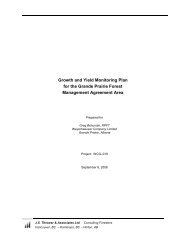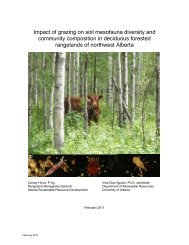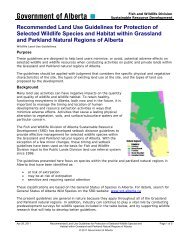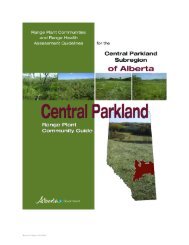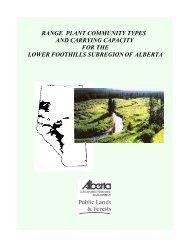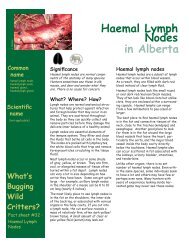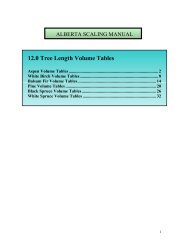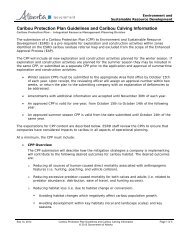Foothills Fescue Range Plant Community Guide - Sustainable ...
Foothills Fescue Range Plant Community Guide - Sustainable ...
Foothills Fescue Range Plant Community Guide - Sustainable ...
Create successful ePaper yourself
Turn your PDF publications into a flip-book with our unique Google optimized e-Paper software.
lowlands, solonetzic soils, some sandy soils). Erosion and sediment production from sites<br />
that are normally unstable is not the focus of this question, but rather the loss of key soil<br />
particles from well developed sites that are normally stable.<br />
Human-caused bare soil is rated by considering the total bare soil on a range site minus<br />
the amount that is normally naturally occurring. For most sites in the <strong>Foothills</strong> <strong>Fescue</strong><br />
grassland, there is normally no bare soil. The following table shows the normal range of<br />
mean soil exposure values observed in the plant community data. Steep slopes, gravelly<br />
soils and thin break sites may have up to about 10% naturally occurring bare soil (Table<br />
12).<br />
Table 12. Soil exposure normals for major range sites in the <strong>Foothills</strong> <strong>Fescue</strong> grassland.<br />
<strong>Range</strong> Sites Soil Exposure<br />
(% canopy cover)<br />
Loamy<br />
• Loamy 1 moist<br />
• Loamy 2 mid<br />
• Loamy 3 dry<br />
• Loamy steep<br />
0-1%<br />
0-5%<br />
0-8%<br />
5-8%<br />
Gravel and Shallow-to-Gravel 5-10%<br />
Thin Breaks 5-10%<br />
7.5 Question 5 - Noxious weed infestation.<br />
Noxious weeds are invasive plants that are alien species to the rangeland plant<br />
community. Weeds are seldom a problem in vigorous, well managed pastures although<br />
weed invasion may occasionally happen in healthy stands. Weeds may be introduced to<br />
relatively healthy stands through rodent burrows, but generally their presence indicates a<br />
degrading plant community. Noxious weeds diminish the agricultural productivity of a<br />
site, and threaten biological diversity and the structure, function, and sustainability of<br />
ecosystems. They diminish the multiple uses and values that range is normally capable of<br />
providing.<br />
Weeds normally provide a strong message about range health. Weeds most often invade<br />
range where grazing practices have resulted in available niche space (bare soil, surplus<br />
moisture); available micro-habitats normally occupied by range plants, but now available<br />
to weeds due to overgrazing or some other land use or natural disturbance. Grazing<br />
management strives to maintain plant vigor and vegetation cover so that all niche space is<br />
filled by one or more plant communities that can occupy the site and thereby minimize<br />
weed invasion.<br />
67



